
Orb-weaver spiders are members of the spider family Araneidae. They are the most common group of builders of spiral wheel-shaped webs often found in gardens, fields, and forests. The English word "orb" can mean "circular", hence the English name of the group. Araneids have eight similar eyes, hairy or spiny legs, and no stridulating organs.
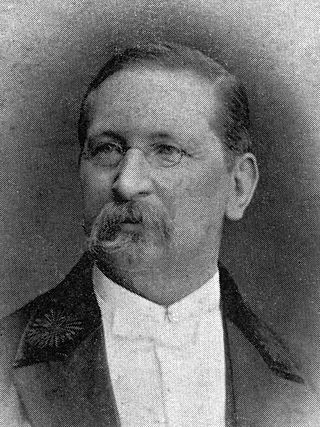
Tord Tamerlan Teodor Thorell was a Swedish arachnologist.
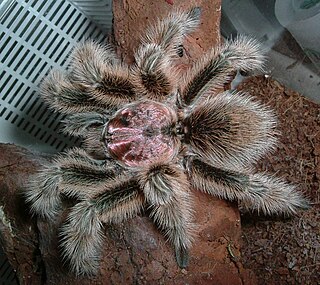
Grammostola is a genus of South American tarantulas that was first described in text by Eugène Louis Simon in 1892. These medium- to large-sized spiders are native to tropical South America, and are usually brown in color, with pinkish or orangish-red hairs. The very docile Chilean rose tarantulas are popular as a beginner's spider among tarantula enthusiasts.

Dwarf tarantulas, also known as sheet funnel-web spiders are a type of spider from the family Mecicobothriidae. Dwarf tarantulas are one of several families of the suborder Mygalomorphae; this larger group also includes the true tarantulas.

Actinopus is a genus of mygalomorph spiders in the family Actinopodidae. It was first described by Josef Anton Maximilian Perty in 1833 from the type species Actinopus tarsalis found in Brazil. The name is derived from Greek actin- "ray, beam" and pous "foot". It is a senior synonym of Aussereria, Closterochilus, Pachyloscelis, and Theragretes.
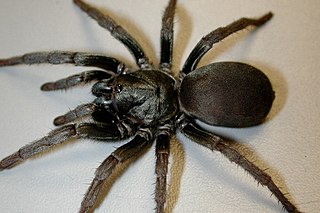
Nemesiidae, also known as funnel-web trapdoor spiders, is a family of mygalomorph spiders first described by Eugène Simon in 1889, and raised to family status in 1985. Before becoming its own family, it was considered part of "Dipluridae".
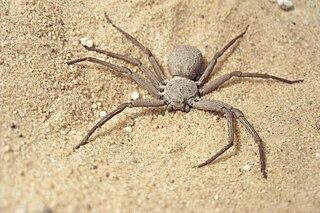
Sicarius is a genus of recluse spiders that is potentially medically significant to humans. It is one of three genera in its family, all venomous spiders known for a bite that can induce loxoscelism. They live in deserts and arid regions of the Neotropics, and females use a mixture of sand and silk when producing egg sacs. The name is Latin for assassin.

Eduardo Ladislao Holmberg was an Argentine natural historian and novelist, one of the leading figures in Argentine biology. Together with Florentino Ameghino he undertook the inventory of Argentine flora and fauna, and explored all the ecoregions in the country, summarizing for the first time the biodiversity of its territory. The son of botanical aficionado Eduardo Wenceslao Holmberg and grandson of the Baron Holmberg, Holmburg accompanied Argentine Libertador Manuel Belgrano on his campaigns and introduced the cultivation of the camellia to Argentina. As director of the Buenos Aires Zoological Garden he greatly developed its scientific aspect, publishing booklets and providing printed media for a learned appreciation of its contents. He also directed the Natural History Cabinet of the University of Buenos Aires and published the standard reference works on botany and zoology used in his country for most of the 20th century.

Micrathena, known as spiny orbweavers, is a genus of orb-weaver spiders first described by Carl Jakob Sundevall in 1833. Micrathena contains more than a hundred species, most of them Neotropical woodland-dwelling species. The name is derived from the Greek "micro", meaning "small", and the goddess Athena.
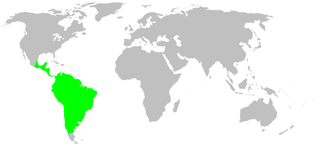
Senoculus is a genus of araneomorph spiders in the family Senoculidae, and was first described by Władysław Taczanowski in 1872. It is the only genus in the family Senoculidae.
Senoculus darwini is a spider species in the genus Senoculus found in Argentina.

Mastophora, also known as bolas spiders, is a genus of orb-weaver spiders first described by E. L. Holmberg in 1876. They can be identified by a pair of lumps on the dorsal surface of the opisthosoma, though not all males will have these lumps.
Stenoterommata is a genus of South American araneomorph spiders in the family Pycnothelidae. It was first described by E. L. Holmberg in 1881. Originally placed with the Ctenizidae, it was transferred to the funnel-web trapdoor spiders in 1985, then to the Pycnothelidae in 2020. It is a senior synonym of Ctenochelus.

Mecicobothrium is a genus of dwarf tarantulas first described by Eduardo Ladislao Holmberg in 1882.

Mecynogea is a genus of orb-weaver spiders first described by Eugène Simon in 1903. The name is derived from the Greek mekyno (μηυνω), meaning "to lengthen", and "gea" (γεα), meaning "earth".
Pronous is a genus of South American and African orb-weaver spiders first described by Eugen von Keyserling in 1881.
Pycnothelidae is a family of mygalomorph spiders first described in 1917. It was downgraded to a subfamily of the funnel-web trapdoor spiders in 1985, but returned to family status in 2020.

Mecicobothrium thorelli is a spider in the family Mecicobothriidae, native to Argentina and Uruguay. It was first described in 1882 by Holmberg. The specific name thorelli honours Tamerlan Thorell. The species is most abundant in autumn and winter.
Mastophora extraordinaria is a species of spider in the orb-weaver spider family Araneidae. It is found in South America. Like some other species of the genus Mastophora, adult females resemble bird droppings. Mastophora species, including M. extraordinaria, are "bolas spiders" – adult females capture their prey by using a sticky drop on the end of a single line which they swing at the target, usually a male moth attracted by the release of an analogue of the attractant sex pheromone produced by the female moth. Juveniles and adult males do not use a bolas, catching prey with their legs alone.












